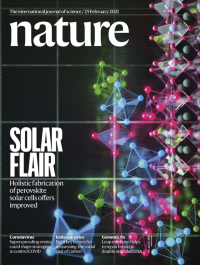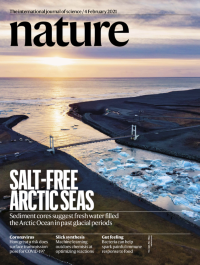Volume 590
-
No. 7847 25 February 2021
Solar flairThanks to their potential high efficiency, solar cells based on metal halide perovskites are strong candidates to replace today’s silicon-based cells, but the light-harvesting ability of perovskites remains limited owing to excessive charge-carrier recombination. In this week’s issue, Jangwon Seo and his colleagues report a holistic approach to making perovskite solar cells that improves the management of charge carriers. The researchers have developed a deposition technique that creates high-quality tin oxide electron-transport layers, which they couple with a strategy to precisely control the combination of two perovskite materials in order to improve the opto-electronic properties without sacrificing the bandgap of the active layer in the solar cell. The resulting solar cells have a power-conversion efficiency of 25.2%, which is close to the capabilities of silicon cells, demonstrating that the performance gap between the two technologies is rapidly narrowing.
-
No. 7846 18 February 2021
Probing twistronicsThe discovery of superconductivity in twisted bilayer graphene sparked interest in the electronic properties of similarly distorted 2D crystal lattices. The twisted structure is created by slightly rotating two crystal networks in bilayer graphene, but the resulting lattices need to be imaged at the atomic level for their properties to be understood. In this week’s issue, Ado Jorio and his colleagues use visible light in a nano-Raman spectroscope to image reconstructed twisted bilayer graphene and to probe the vibrational modes of the lattice. The technique revealed the localization of some vibrational modes and allowed the team to study how these influence electronic properties. The researchers note that the results are a step towards understanding phonon-related effects and could aid the development of ‘twistronics‘.
-
No. 7845 11 February 2021
Genome revolutionTwenty years ago, the Human Genome Project published its first draft sequence of the entire human genome. A sizeable collection of papers, it filled much of the 15 February 2001 issue of Nature, and represented the culmination of some 15 years of work. But it was only the beginning. Since then researchers have plunged eagerly into the ‘post-genomic’ era, and this week, Nature takes stock of how the draft sequence has helped to reshape biological and medical research as well as the challenges of data collection, curation and access faced by today’s projects. The cover image offers a visual representation of how research into human genes has developed. The human chromosomes are represented by concentric rings and the various peaks represent the relative number of publications referencing each gene on the chromosomes before (above the ring) and after (below) the draft sequence’s publication.
-
No. 7844 4 February 2021
Salt-free Arctic seasThe cover shows Diamond beach and Jokulsarlon Glacier lagoon in Iceland. It is thought that much of the Arctic Ocean was once covered by an ice shelf, but clear evidence for this has proved to be elusive. In this week’s issue, Walter Geibert and his colleagues reveal results that suggest that in recent glacial periods the Arctic Ocean and adjacent Nordic seas were filled mostly with fresh water and covered by a thick ice shelf. The researchers analysed marine sediment cores for thorium-230, which is produced from the decay of uranium in salt water. They found that thorium-230 was missing from multiple layers in cores from the Arctic Ocean and Nordic seas, which they interpret to mean that there was no salt water present. The team suggests that the ice shelf effectively created a dam, separating these bodies of water from the Atlantic Ocean and filling the region with fresh water for two periods, 70,000–62,000 and 150,000–131,000 years ago.
Focal Point




